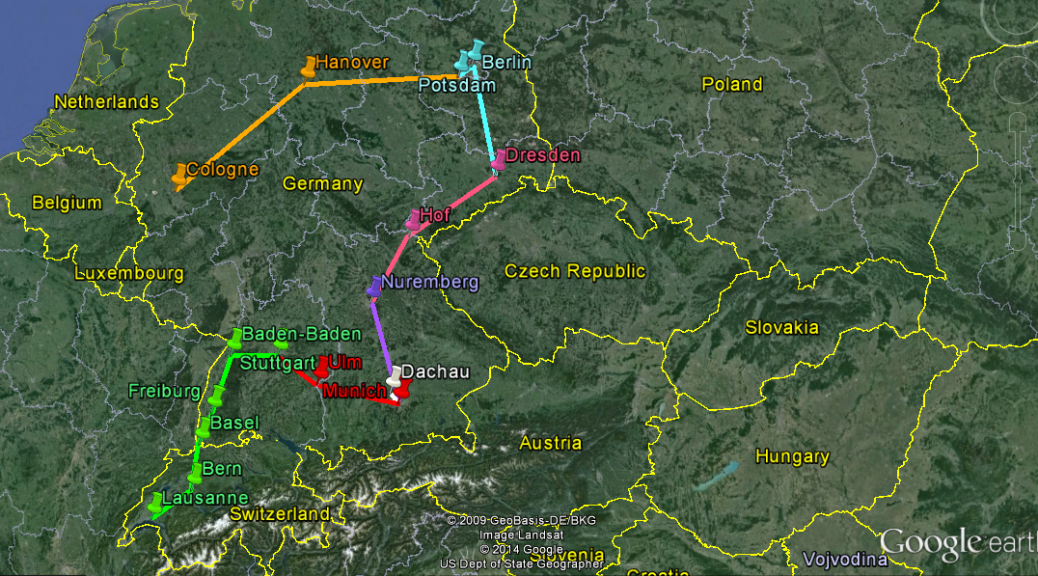Sunday, December 28th we spent the day in Munich and Dachau. We had a long list of things we wanted to see in Munich, but decided to start our day by traveling to Dachau concentration camp since we didn’t know how long it would take to see and didn’t want to miss it.
Getting to Dachau took longer than we thought. We missed our train by seconds and had to sit and wait twenty minutes for the next one to come along. Once we reached Dachau, our completely full train emptied out and we waited half an hour with the crowd for the city bus. We were lucky to squeeze onto the bus, it was so crowded some people couldn’t get on and would presumably have to wait another half hour for the next bus. An Australian tour guide was on the bus and listed of some facts in English as we went along, such as the route the bus takes is the same the prisoners of the camp were forced to walk, and that we drove by the compound where the SS officers used to live.
Once at the camp we stopped first at the little visitors center by the bus stop. They had some informational displays and a very long line of international tourists grabbing audio guides. Lucky for us all the displays in the camp are in both German and English.
We then walked to the main gate, it was sad to see that the iconic “Arbeit Macht Frei” sign was gone, recently stolen in 2014 according to a sign set by the gate.
For me, walking through Dachau reminded me why traveling is important. I knew the history of the holocaust, thanks mostly to a good teacher in eighth grade, but the feeling of being there was more than I thought it would be. The best I can do to describe it is that it had the feeling of quiet respect like walking into a large cemetery, the sense of history stepping onto a battlefield, and the sense of fear and unease you feel when you are 5 and walk into a haunted house all wrapped together.
Our tour through the camp was first through one of the barracks used to house prisoners. The dark lights and the paint peeling on plain cement walls gave it an eerie look. The curators do a good job of putting displays in the cells telling of life and death of individuals in the camp.
The main building for information and displays is the large former maintenance building. We spent about an hour walking through reading about prisoners, medical experiments, torture, and other tragic stories. We left without seeing everything, after a while it starts to feel overwhelming reading it all.
We left the information building and walked to the other end of the camp where there are four religious memorials: Jewish, Catholic, Protestant, and Russian Orthodox.The falling snow made a peaceful scene, a sharp juxtaposition to exhibit hall we had just walked through.
The last building we visited, just outside the camp fence, was the crematorium. I made it through the first room, which a sign said used to have bodies stacked to the ceiling waiting for the furnace. Then we walked into the room with the furnaces and it was a bit overwhelming for me and I had to step outside. Melissa finished walking through the building, then we headed back to Munich.
In Munich we visited two history museums that showcased ancient Greek and Roman statues, vases, jewelry, and other artifacts. Then visited the Alte Pinakothek painting museum, which houses lots of medieval paintings, though Raphael and da Vinci were the only painters I’d heard of. My only complaint about the painting museum was that it was so crowded it was at times hard to move through the people to see the art.
For dinner we walked to a different beer hall called Zum Augustiner. We had really good beer and food, roast pork for me and veal meatballs for Melissa.













Phil,
What’s even more extraordinary is the fact that there was a genocide in Rwanda in the 1990’s that wiped out hundreds of thousands. The international community did nothing to stop this, probably partially because they were black Africans.
What would we do if we were in a similar situation? We’re pretty smug about what our reaction would be (because of pride), but we need to consider our fallen human nature.
It’s a horrible thought, but I think that if I had been born in Rwanda and was part of the ethnic group that engaged in the cleansing, I would have taken part. After all, I’m assuming that a good portion of the men did, or at the very least did nothing to stop it.
There’s a story that St. Francis of Assisi passed by a scene where a criminal was being condemned to death. The saint then stated that if it hadn’t been for the graces that God had given him, he would be that man.
Kevin
Yes, so many genocides have happened in history and continue to today it seems like it’s human nature. There is a lot of psychological/sociological research that shows people are stupid when they are in groups. I think the answer is education, but now you’re making me wonder a stupid question. The concentration camp was good at showing the history but didn’t answer the question “What should you do if you think your country is about to commit genocide?” If you spoke out you’d probably get murdered, I think I’ll do some research I’m sure someone else has thought of this before.